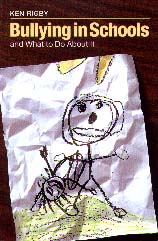|
________________
CM . . . .
Volume VI Number 6 . . . . November 12, 1999
excerpt: For children to apply these principles, they must be able to utilise specific skills in pressure situations. They should be able to recognise unreasonable requests and make assertive, non-aquiescing responses. They should know when they are being manipulated or coerced - and resist. Where name-calling is the form of abuse, children need to be able to stay calm and relaxed, and respond neutrally. How to get bystanders to intervene when it becomes necessary is a further skill that can be of great value to them. Finally, it is important for them to know how to leave a hostile situation.Bullying is on the increase in many schools around the world, and educators are finally taking it seriously. In this book, Rigby, a Professor of Social Psychology at the University of South Australia, provides readers with some proven strategies to help schools deal with this widespread problem and offers sound advice to ensure the strategies' success. The book's introduction gives a definition of bullying and some patterns of the bully-victim interaction. Ten chapters follow in which Rigby teaches educators how to start a school-wide anti-bullying program that benefits both the bully and the victim. Topics include the creation of an anti-bullying policy (very important!), methods of gaining support from students, humanistic approaches to bullying (including the Method of Shared Concern in which the bully and the victim are first interviewed separately, then brought together to solve their problem), supporting the victim, and using students as peer helpers. Citing research done on this issue, the author is very frank in his discussion of what works and what doesn't. He admits that the problem of bullying won't be solved overnight and cautions educators to take small steps to create a program with which all stakeholders can be satisfied. Rigby suggests that, where possible, the topic of bullying should not be discussed in isolation, but rather integrated within the regular curriculum. For example, a novel studied in language arts class could have bullying as its central theme; history classes could examine oppression, ethnic cleansing or slavery - the ultimate form of bullying. A reference list and an index are provided as well as a list of resources for teachers and parents. Some of these resources, such as videos, can be used in the classroom. (In a few cases, Rigby even provides Canadian addresses where these resources can be obtained.) Though the topic of this book is a very serious one, the text is fairly light and moves along at a good pace. Thought-provoking and well-researched, this book offers a blend of creative options and practical advice for educators wishing to implement a program that will ultimately benefit not only the school community, but also the community at large. Recommended. Gail Hamilton is a teacher-librarian at Bird's Hill School in East St. Paul, MB.
To comment on this title or this review, send mail to cm@umanitoba.ca.
Copyright © the Manitoba Library Association.
Reproduction for personal use is permitted only if this copyright notice
is maintained. Any other reproduction is prohibited without
permission.
Published by
TABLE OF CONTENTS FOR THIS ISSUE - November 12, 1999.
AUTHORS |
TITLES |
MEDIA REVIEWS |
PROFILES |
BACK ISSUES |
SEARCH |
CMARCHIVE |
HOME
|
